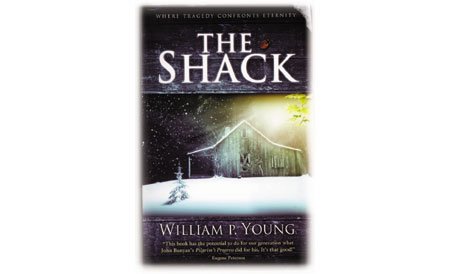While hurtling through the air last week, 30,000 feet above the
Atlantic, I discovered just how long 12 hours can be. Despite
dozing, watching videos, eating
– time seemed interminable.
While hurtling through the air last week, 30,000 feet above the Atlantic, I discovered just how long 12 hours can be. Despite dozing, watching videos, eating – time seemed interminable.
Searching through my carryon bag for some diversion, I discovered a book given to me by my sister-in-law, a Presbyterian deacon. What better time to give it a try, I asked myself, as I began reading the recommended story.
This somewhat controversial best-selling novel, “The Shack” by William P. Young, explores the answers to life’s great questions through an encounter between a grieving father and the three-person God of Christianity.
Using a startling metaphor, the author illustrates his understanding of the relationships between God, Jesus Christ, the Holy Spirit, and the mortals living ordinary lives on earth today.
The story’s narrator is Willie, a friend of the book’s protagonist, Mackenzie Allen Phillips (commonly referred to as “Mack”). The author’s folksy style is introduced in the book’s forward, and the appreciation for this style may influence the reader’s enjoyment of the novel.
Mack had an unhappy childhood, influenced by a father who was both a devoutly religious Christian and a brutal alcoholic. Now happily married, he decides to take his three children on a camping trip to Wallowa Lake in Northeastern Oregon. His wife, a nurse named Nan, must miss out on this adventure because of a previous commitment to attend a continuing education class in Seattle.
While his two older children are paddling in a canoe, it overturns and throws them into the water. Mack leaves his younger daughter behind while trying to rescue Josh and Kate from drowning. When he returns to the campsite, Missy has disappeared.
Soon Mack and the authorities discover that she has been kidnapped and murdered by a mysterious serial killer, known as the Little Ladykiller. The remainder of the story deals not so much with the abduction and murder, though this mystery is resolved, as with Mack’s attempt to come to terms with “The Great Sadness” he falls into because of this tragedy.
Four years later a mysterious note lures Mack back to the isolated shack where Missy was murdered, and there he has an experience which teaches him about God and reconciles him to accept his new life without Missy.
Apparently, “The Shack” has become quite popular within the Christian community, reaching number one on The New York Times paperback fiction list last month. But it also has detractors who find dangerous heresy in some of its passages.
William P. Young, the author, was born in 1955 to missionary parents in Alberta, Canada, and spent his first decade living among the indigenous people of “Netherlands New Guinea (West Papua).”
After graduating from Warner Pacific College in Portland, Ore., Young worked on the staff at a large suburban church while attending seminary. He mentions various careers he has followed: owned businesses, worked in insurance, construction, food processing and “whatever was needed to help feed and house” his growing family. Although he has done a good deal of business writing, “The Shack” was written for his children “with no thought or intention to publish.”
At the end of the book is included an explanation of The Missy Project, an effort to promote the book “across the broadest reaches of our culture.” It suggests ways that readers who have appreciated the novel can share its message with others. The project must be effective, judging by the number of copies sold so far (estimated at 350,000 to a million).
For more information, visit www.theshackbook.com.














